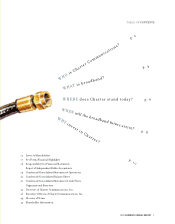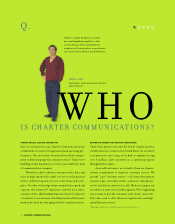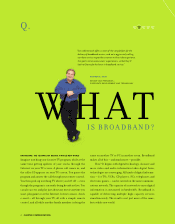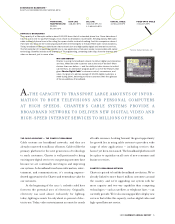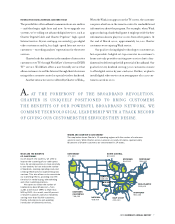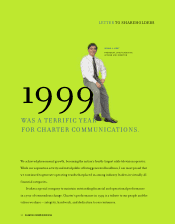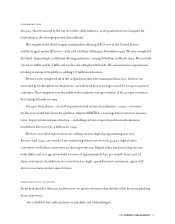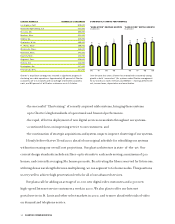Charter 1999 Annual Report Download - page 7
Download and view the complete annual report
Please find page 7 of the 1999 Charter annual report below. You can navigate through the pages in the report by either clicking on the pages listed below, or by using the keyword search tool below to find specific information within the annual report.
A.THE CAPACITY TO TRANSPORT LARGE AMOUNTS OF INFOR-
MATION TO BOTH TELEVISIONS AND PERSONAL COMPUTERS
AT HIGH SPEEDS. CHARTER’S CABLE SYSTEMS PROVIDE A
BROADBAND NETWORK TO DELIVER NEW DIGITAL VIDEO AND
HIGH-SPEED INTERNET SERVICES TO MILLIONS OF HOMES.
THE CABLE ADVANTAGE — THE POWER OF BROADBAND
Cable systems are broadband networks, and they are
already connected to millions of homes. Cable will be the
primary platform for the next generation of technology
to reach customers. Charter is well positioned to bring
exciting new digital services to our growing customer base
because we are continually investing in and improving
our systems. As broadband transforms information, enter-
tainment, and communications, it’s creating unprece-
dented opportunities for Charter and tremendous value for
our customers.
At the beginning of the 1900’s, nobody could have
foreseen the potential uses of electricity. Originally,
electricity was used almost exclusively for lighting;
today, lighting accounts for only about 20 percent of elec-
tricity use. Today, video entertainment accounts for nearly
all cable revenues. Looking forward, the great opportunity
for growth lies in using cable systems to provide a wide
range of other applications — including services that
haven’t yet been envisioned. The broadband platform will
be a place to capitalize on all sorts of new consumer and
business services.
CHARTER’S BROADBAND NETWORK
Charter is poised to lead the broadband revolution. We’re
already linked to more than 6 million customers around
the country, and we’re upgrading our system with far
more capacity and two-way capability than competing
technologies — such as satellites or telephone lines — can
currently provide. We’re also moving quickly to deploy new
services that utilize this capacity, such as digital video and
high-speed Internet service.
TRADITIONAL
TELEPHONE LINE
28,800-
56,000 BPS
COMPARATIVE BANDWIDTH*
IN BITS OF INFORMATION PER SECOND (BPS)
ISDN LINE
128,800 BPS
DSL LINE
384,000 BPS TO
1.5 MILLION BPS
*Source: Vulcan Ventures, Inc.
COAXIAL CABLE
10 MILLION BPS
FIBER-OPTIC CABLE
3 BILLION BPS
HOW BIG IS BROADBAND?
The capacity of a fiber-optic cable is about 100,000 times that of a standard phone line. Since data doesn’t
have to wait in line to squeeze through, it can reach its destination much faster. Sending data by fiber-optic
cable instead of phone lines is like riding the space shuttle instead of walking. And this comparison doesn’t
even take into account the continuing improvement in technologies to enhance fiber-optic communications.
Today, broadband makes possible faster data transmission and high-quality digital and interactive services.
The full potential of increased bandwidth lies in new applications that were simply inconceivable with earlier
technology. Benefits include more channels of TV programming, streaming video clips from the Internet and
video on demand, just to name a few.
1999 SUMMARY ANNUAL REPORT 5
WHY BROADBAND?
Charter is using its broadband network to deliver digital and interactive
services. What does the customer see at the end of the line? More
choices than ever before — and the ability to tailor choices to individ-
ual interests. An interactive program guide is one of the features that
gives Charter Digital CableTM customers control, convenience, and
value. Our goal is to add an average of 10,000 digital customers a
week during 2000, delivering to those customers their first glimpse
of the possibilities of broadband.



